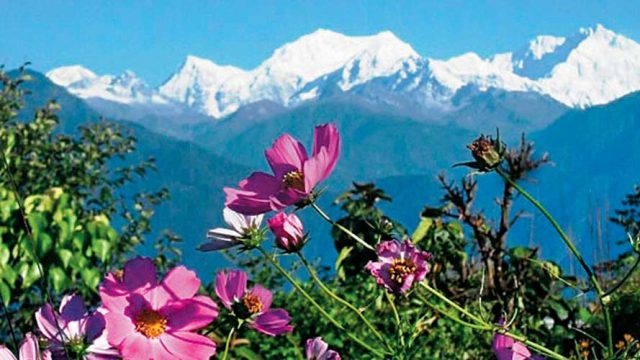Barsai Rhododendron Sanctuary spreads across the Singalila Range, which forms the natural international border with Nepal. In the south, the Rambong Khola separates it from West Bengal.
The sanctuary forms a vital corridor connecting the Khangchendzonga Biosphere Reserve in the north with the Singalila National Park in West Bengal in the south. The site contains several forest types, such as sub-tropical deciduous, sub-alpine, moist temperate and wet temperate. July is the wettest month in the sanctuary, with average annual precipitation of 250cm. The reaches above 2,500m receive snowfall annually.
With its cold and wet climate, rhododendrons flourish here. About 600 varieties of rhododendrons, out of the 1,000 known varieties in Sikkim, are found in this sanctuary. It is also home to the rare Himalayan red panda and black bear. Meadows take over from above 4,000m and are rich in medicinal plants. Flowers are in full bloom from March to June.

The Barsai sanctuary can be reached from three points, Hilley, Dentam and Soreng. The most popular point of entry is Hilley, which can be reached by road, after which Barsai is a short, and absolutely fulfilling, 5km-trek via a beautifully laid gravel path shaded by many species of rhododendrons. The bridle path heads due north along the Singalila Ridge, with views of the Khangchendzonga. The gradual climb will take no more than an hour and a half. While it is possible to leave Hilley early in the morning and be back by lunchtime, it is certainly more fun to stay at Barsai for a night to enjoy the rhododendron forest.
Hilley is 77km away from Namchi, via Sombaria and Jorethang. Only hired taxis will go all the way to Hilley; shared taxis and buses go up till Sombaria, which is some 100km away from Hilley. Wear heavy wool-lens, snow shoes, and gloves during winters; light woollens during the rhododendron blossom months – also remember to carry sleeping bags, raincoats and umbrellas. Entry permits can be obtained from the Wildlife checkpost at Hilley.
Park Entry Indians ₹50 per day; Foreigners ₹100 per day Tent pitching ₹40 per day Photography ₹20 per day Videography ₹750 per day Environment fee ₹1,000 per group.
Stay at Guras Kunj (Cell: 09593834627; Tariff: Rooms ₹3,000, dorm bed ₹900 per person and tent ₹800) in Barsai, amidst the rhodo-dendron forests. Book in Barsai or contact Help Tourism. The Forest Bungalow (Cell: 09733065937; Tariff: ₹1,100 with meals) arranges for treks inside the sanctuary.

AROUND THE SANCTUARY
Hee
Located at the edge of the sanctuary, the Hee Bermiok region happens to be a Limbu stronghold and visitors are sure to hear stories here of the great Limbu leader Srijunga.
An inspiring chieftain, Srijunga developed a script for the Limbu language and grew to be influential enough to challenge the Bhot ruler of the time. He also warded off several murderous attacks. Srijunga’s Bhot wife was tortured into revealing her husband’s Achilles-style weakness and he was killed with a blow to the stomach. A rivalry of sorts still thrives between the Bhots and the Limbus.
Gufa Dara is a hill here that bears a 108-ft-high statue of Srijunga. It is a commemerative site but it comes with the side benefit of being visible for miles – a sight quite certain to torment the predominantly Bhot-inhabited regions on the other side, who still consider Srijunga the enemy.
The only accommodation in Upper Hee is a Help Tourism Barsai Jungle Camp (Kolkata Tel: 033-24550917; Tariff: ₹3,500 for 2 pax all inclusive), but it is perfect. Meals cost extra.
Rhododendron Country
The rhododendron flower is the breath-taking glory of Sikkim and the land boasts of some 30 species, from the gigantic rhododendron grande, a tree that grows upto the staggering height of 40ft, to the diminutive nivale that rises barely two inches from the ground! Some, like the dalhouse, are epiphytes growing on top of tall trees, barely visible from below. Others are painted prima donnas: like the conspicuous falconeri, with its large fleshy leaves covered with rust-coloured filaments on their underside. The rhododendron literally lives off its looks to attract bees and butterflies, as none of the species are fragrant.
The forest trails of Sikkim were also the favourite stamping ground of the man who systematically explored the land and documented the flora and fauna of the Eastern Himalayas. After Joseph Dalton Hooker obtained his MD from Glasgow University in 1839, young Hooker travelled extensively for most of his life, going off on botanical expeditions to all corners of the world. He came to Sikkim for the first time in 1848, and his year-long travels resulted in an amazing record of the numerous species of animal and plant life, many of which turned out to be new discoveries. Numerous species of rhododendrons, ferns and orchids are named after Hooker. He published Rhododendrons of Sikkim in 1849, and the text is considered an authoritative work even today, while Himalayan Journals, a travelogue, is a classic treasured by naturalists, historians as well as sociologists.
Arundhati Ray
FAST FACTS
When to Go All year round. Best time: March–June, November–March
Tourist offices
Sikkim Tourist Information Centre, MG Marg, Gangtok, Tel: 03592-209090, STD code 03592
GETTING THERE
State Sikkim
Location In the Singalila Range of Western Sikkim
Distance 126km W of Gangtok
Route from Gangtok Take NH710 via Namchi
Air Bagdogra (109km/ 3.5hrs). Taxi to Namchi costs ₹4,500–5,000
Rail New Jalpaiguri (106km/ 3.5hrs). Taxi costs ₹4,500– 5,000
Road From Siliguri (100km/ 3hrs), take NH31A to Melli via Teesta Bazaar. From Melli, follow the Rangeet River to Jorethang Bus From Siliguri, there are good connections to Jorethang. Namchi to Hilley (77km/ 3hrs) can be covered in a jeep. An independent taxi needs to be hired from Sombaria (29km from Jorethang) for Hilley. Barsai is 5km further and can be approached by a trekking trail (2hrs).




